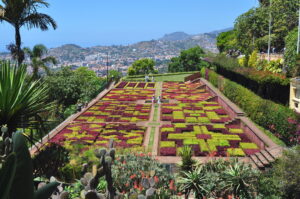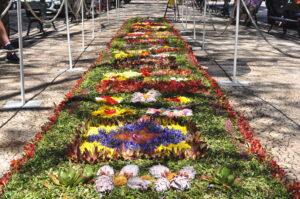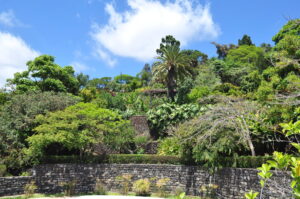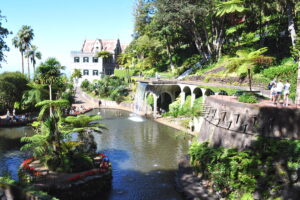Gardener’s Heaven
May 23rd, 2023
There’s a place on this planet where the soil is rich and well-drained, where temperatures sit in the pleasant 70s all year, where the sun shines day after day, and best of all, where deer don’t tread.

My favorite garden view on Madeira… the quilt garden in Funchal’s Madeira Botanical Garden.
This gardener’s heaven is the Portuguese island of Madeira, a volcanic blip in the Atlantic Ocean located 320 miles off of the west coast of Morocco.
Its southerly location (about the same latitude as Charleston, S.C.) ensures year-round warmth, while its surrounding water keeps it in that stable and plant-perfect 70s range. It’s like eternal spring.
Unlike in our deer-infested yards of root-blocking clay and extreme, erratic weather, plants in Madeira show their gratitude with incredibly lush, diverse, and healthy growth.
I got to see what a difference prime conditions breed on a visit earlier this month to Portugal and its Azore and Madeira islands. (See pictures in a new collection I’ve posted on my Photo Gallery pages.)
Given the trifecta of great soil, ideal weather, and few bug, disease, and animal attackers (a side benefit of ocean isolation), it’s easy to see why Madeira is sometimes called a “floating garden” and the “pearl of the Atlantic.”
Before our tour, Collette Vacations’ Matt D’Eramo told us that “if Hawaii and Ireland had a child, it would be Madeira.”
That’s a good assessment. The island is very Hawaii-esque with its rugged peaks and tropical plant lineup, yet it has the lushness, multiple shades of green, and some of the more familiar northerly plants of Ireland.

Madeira is warm and rugged but also lush and green.
Pretty much everything is happy to grow in Madeira – especially the sunnier, drier south side of the island, which is sheltered from the north side’s trade winds by central volcanic mountains that top out around 6,000 feet up.
The two sides of the mountains and the varying heights give the island six distinct microclimates – all of them better than anything in central Pennsylvania, from what I can tell.
The lower and southern parts are warm enough to support a thriving banana industry, not to mention crops of guava, passion fruit, and mango.
Species we know as “houseplants” grow in the ground in the subtropical Mediterranean environment – agaves, snake plants, jade plants, birds of paradise, and spider plants, to name a few.
Go a little higher where it’s slightly cooler, and plants such as camellias (common in the U.S. South), tree ferns, wine grapes, and tree heathers do really well.
Higher still is Madeira’s World Heritage Site laurasilva forest. This 58-square-mile mountaintop region is special because it’s home to species of broadleaf evergreen laurel trees that go back to dinosaur times.
Laurel forests were common 20 to 40 million years ago before the Ice Age wiped out most of them. The only surviving remnants are the stands on Madeira, the Azores Islands to the north, and Spain’s Canary Islands to the south.
Another special tree of Madeira is the jacaranda, a South American native that blooms purple in spring.

Jacaranda trees are blooming purple as a street tree in Funchal.
These are gorgeous small trees, often planted as street trees. We were lucky to be in Madeira just as the jacarandas were reaching peak bloom.
We have no trees that bloom in this color. Picture a dogwood with flowers the color of a purple lilac or a purple iris, and you’ll get an inkling of the jacarandas’ beauty. Of all the Madeira plants, this is the one I most wish we could grow.
That’s saying a lot for a plant palette that features neon-rose bougainvillea vines draping over fences and walls, pink oleander shrubs blooming along the roadsides, and hibiscus plants showing off their big red trumpets.
Even the “weeds” are beautiful in Madeira.
Blue and deep purple morning glory vines have seeded in to grow wild on walls and fences alongside the bougainvilleas.
Hydrangeas are so happy there that they’re growing wild in openings where our climate gives us invaders like multiflora roses, Japanese knotweed, and trees of heaven.
And those golden and orange “weeds” I saw growing out of the ditches and roadside aprons turned out to be nasturtiums – an annual we plant intentionally for summer color.
The good news is that Madeira’s 251,000 inhabitants appreciate the hand of aces they’ve been dealt.
Madeirans largely love their flowers and plant all sorts of them (lantana, roses, salvias, blue agapanthus, bromeliads, osteospermums, fuchsias, etc.) to supplement what nature provides.
Since the island is so hilly, most home gardeners plant in terraces. Many also pack flowers into pots in every available inch of their entryways, patios, and house foundations.
“We can’t live without flowers,” our local guide, Sonia, told us. “There is something in our blood that we have to have flowers.”

These sidewalk “flower carpets” are a highlight of the annual Madeira Flower Festival.
While this 13-by-35-mile island is colorful every day of the year, it’s especially colorful during the Madeira Flower Festival, held each year for about three weeks from late April to mid-June.
The highlights are a parade with floats (similar to Pasadena’s rose parade) and downtown Funchal’s sidewalk “flower carpets,” which are elaborate, quilt-like designs made out of assorted cut flowers laid out with the aid of frames.
I’ve never seen anything like these anywhere else. They’re likely unusual because they take a lot of flowers and time to build but also because they take a ton of work to maintain, including the need to water the flower carpets by hand three times a day. Even then, the carpets have to be replaced about every five days.
Madeira also sports two fabulous public gardens.
One is the Madera Botanical Garden, which sits on a steep hillside, overlooking Funchal, the capital city.

Most of the Madeira Botanical Garden is on a terraced hillside.
It has a garden of succulents, a garden of cycads, a topiary garden, gardens of native Madeiran plants, and a collection of trees from around the world. But the signature feature is a huge quilt garden, similar in look to Funchal’s sidewalk flower carpets.
Nearly as big as two tennis courts, this in-ground garden was planted with trimmed red and gold iresine.
It’s particularly stunning because it overlooks the ocean and Funchal’s terra-cotta roof buildings way below.
The other impressive Madeira garden is the even higher-up Monte Palace Tropical Garden.
This one is mostly cobblestone trails that wind down and down and down through subtropical woodlands, walls lined with elaborate, ceramic-tile art, and Oriental gardens featuring pagodas, red bridges, and a distinctive laughing Buddha statue.

This pond and waterfall is the highlight of the Monte Palace Garden.
The highlight is a man-made lake with mountains, waterfalls, and flamingos that serves as the foreground for the one-time palatial home there.
While the plants star at Madeira Botanical Garden, the vistas are what make Monte Palace Tropical Garden outstanding.
I don’t think there’s a bad time to visit Madeira, although May and any time in winter come to mind first. (You can do Christmas in T-shirts.)
A bonus is that prices on the island are surprisingly affordable. The Portuguese, British, and Germans seem to know about this off-the-beaten-path jewel of a vacation island, which has won the World Travel Award’s “World’s Leading Island Destination” honor the last six years running.
On the other hand, most Americans couldn’t tell you where Madeira is, if they’ve heard of it at all.
Now you know.
p.s. The Madeira wine – Washington and Jefferson’s favorite – is another bonus.







